Episode 206
What you’ll learn in this episode:
- How Nicola allows for spontaneity in her work, and how she decides when a piece is done
- Why the texture and physical sensation of jewelry is just as important as its aesthetic
- Why Nicola hopes her jewelry connects the wearer to nature
- How Nicola has forged successful relationships with galleries throughout Europe
- How metals can combine to create harmonious color combinations
About Nicola Heidemann
Nicola Heidemann is a German art jeweler who seeks, through her work, to express her closeness to nature. Heidemann is interested in the ways the shapes and colors of the natural environment inform our sense of beauty, and she considers herself to be a collector—of allusions, impressions, associations.
Additional Resources:
Photos:
“whispering jewel“ Titanium flame coloured, shibuicchi, paint
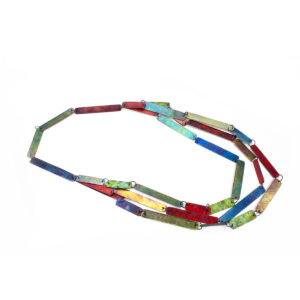
“blue pods“ necklace Titanium flame coloured One side is polished, one side rough
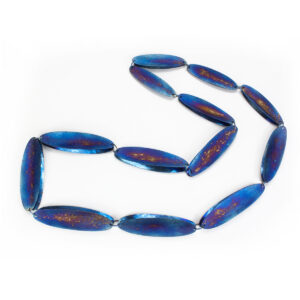
„green tulip“ necklace titanium flame coloured, silver chain
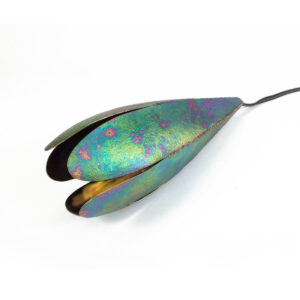
„green pebbles“ titanium flame coloured, silver, paint
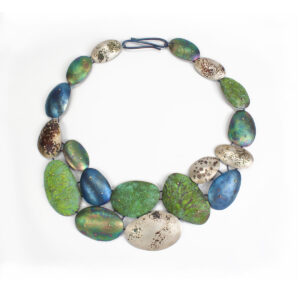
„pebbles beach“ silver, pigments, hidden glas inside
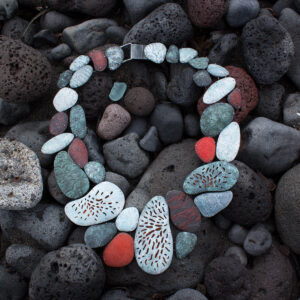
Transcript:
Like nature itself, Nicola Heidemann’s jewelry can never be completely controlled. Using heat coloring techniques to create jewelry that evokes the beauty of the natural world, Nicola allows the material to tell her when the piece is finished. She joined the Jewelry Journey Podcast to talk about the materials she uses the most; why the ability to touch and carry her jewelry is central to her work; and why she hopes her jewelry bonds the wearer to nature. Read the episode transcript here.
Sharon: Hello, everyone. Welcome to the Jewelry Journey Podcast. This is the second part of a two-part episode. If you haven’t heard part one, please head to TheJewelryJourney.com.
Today, my guest is Nicola Heidemann. She’s based in Germany, in Stuttgart, and she founded Nicola Heidemann Jewelry. Welcome back.
I have the earrings and I have the bracelet. It’s a bunch of connections. Do you think about that? Did you sketch out the earrings before you started, or do you sketch out a necklace?
Nicola: Yes, I do. Also, I have a leitmotif to have a memory of how I did it. Most of the time, I also sketch the shapes of the pebbles. For example, the bracelet you have, the pebbles have to match together. I sketch this connection of the pebbles and the shapes of the pebbles so that they are fitting together.
Sharon: Is that how it forms a bond? You say that jewelry forms a bond with nature. How does it form a bond, and what kind of bond does it form?
Nicola: Mainly through my memory or my soul. I feel quite connected with nature. I’m a gardener. A lot of time I spend in my garden and outside in the woods. It’s like a sense or a feeling. It’s my feeling with my bonds to nature. I hope to trigger this. When a person is seeing my jewelry, I hope it’s functioning. I don’t know.
Sharon: Do you think it’s important that somebody understands that before they buy a piece of jewelry? Some artists think it’s important that somebody knows the philosophy. Some do. Some don’t. Do you think it’s important that people know the philosophy behind your jewelry?
Nicola: For me, no, it’s not important. First of all, it’s important that the people have a feeling and they fall in love and they have their own ideas with a piece. Maybe later they can read about my philosophy, but on the first side, I hope the piece is triggering these feelings. So, for me, philosophy is later.
Sharon: I’m curious. How do you sell? Do you sell mostly at popups like Schmuck? Do you sell to galleries, or do you ramp up because Christmas is coming? How do you work?
Nicola: I sell exclusively with galleries. For me, that’s the best way because they know the audience; they know my work. I have wonderful gallerists and gallery owners who are supporting me and I am in connection with them. I always have discussions with them. It’s really supportive. I love this gallery system because I can work at my studio. I send them my pieces and they say, “O.K., people love it,” or sometimes, “Please make it a bit shorter.” I love that.
Sharon: Do they ask you for changes sometimes? Like you said, they want it shorter. Do they say to you, “We need more bracelets,” or “We need a ring,” or “we need necklaces”?
Nicola: Yes, sometimes. One of my really important gallery owners is Gallerie Slavik in Vienna. She’s really supportive, and she makes amazing work at her gallery. For me, the information I get from her about how my pieces are—
Sharon: How they’re seen? If I see them in a case, first of all, they’re distinctive. I know it’s your piece. If I see it, I know automatically who made it. Do you think other people see that?
Nicola: I think yes. I think I’m quite known in the field for now.
Sharon: Known in the field throughout Europe? I don’t see your jewelry in the States. I wonder, are you known here? Are you known in Eastern Europe? Where are you known?
Nicola: In Europe. I used to work with the States, but for the moment, it’s so complicated. I leave it up to the gallery owners to send the pieces. It’s a part of the work I don’t like, this paperwork and customs. I’m really grateful that gallery owners do that for me.
Sharon: Did you always like jewelry or small things? You said you like small things. Did you always like jewelry?
Nicola: Yes. I started quite early with some wire and, as I told you, some wooden pieces or pebbles. I started to learn it in my own studio. I think that was 38 years ago. Yes, I started with my own studio.
Sharon: Wow, that’s a long time!
Nicola: Yeah, and I was really researching and experimenting. I wasn’t a trained jeweler. I was taught by myself.
Sharon: Did you work with other metals besides titanium and copper? Did you experiment with other metals and come back to the titanium?
Nicola: I started with copper and brass and silver. The titanium I think I found maybe 10 years ago; I’m not sure.
Sharon: What did you like about it? It seems like you made a lot.
Nicola: In former times, I used to put color into my jewelry with gemstones. I really love color, and this was a possibility to put silver jewelry with some of my gemstones, but it was too small for me. I wanted to have bigger fields of color. When I explored the titanium, I fell in love with the color possibilities. On the other side, it’s really weightless. You can make really big, bold jewelry pieces, but they are very comfortable to wear because they are so light.
Sharon: Yes, they are.
Nicola: It’s two qualities. It’s really light and it’s this colorful quality.
Sharon: When you’re gardening, what do you find? Does that give you ideas? You mentioned flowers. What do you like to garden?
Nicola: I did learn in my garden as well. I can put some flowers in, but nature will decide if they can stay there, and nature sends me different flowers. Some people call them weeds, but for me, it’s wildflowers. My garden is full of wildflowers and vegetables. It’s a bit of a chaotic mixture, but it’s like in nature. The colors are beautiful. I’m always surprised about how my garden is developing similar to my jewelry. I’m surprised.
Sharon: It seems like it is similar to jewelry in that you wait for the garden to come up. You don’t start and think, “It has to be this way.” That’s interesting.
Are you starting to make a lot of new pieces? Is there a demand for new pieces at Schmuck and for Christmas? Are you busier now than other times of the year?
Nicola: Now, I’m not. For me, Christmas is not so important. The galleries are selling all year, so Christmas is not so important. Sometimes I prepare an exhibition when I try to make a bigger collection, but normally I work as I like and as I feel.
Sharon: Do the gallery owners, the gallerists, ever call you up and say, “It’s been a long time since we’ve seen anything from you”? Do they bug you? Do they notice if you haven’t sent something?
Nicola: I’ve been in good contact with all my gallery owners. That’s maybe a reason why I like to have gallery owners in Europe. I visit them. I really love to visit my gallery owners. I go to Amsterdam or Vienna or Ravensburg. For me, the contact is really important.
Sharon: Do you they know you’re coming or do you walk in?
Nicola: No, they know. We have an appointment.
Sharon: What do you want people to remember when they wear your jewelry? What kind of feeling do you want them to have?
Nicola: I want them to remember that our planet is beautiful. We are part of nature and we can be very, very lucky to spend some time here and to enjoy nature’s beauty.
Sharon: Do you think it’s important that somebody recognizes that?
Nicola: Yes, definitely. Facing all of our problems with climate change and extinction of fauna and flora, yes, I think it’s really important to remember that nature is our home and we are a part of it. Definitely.
Sharon: Sometimes I wonder when it is art jewelry. There’s a meaning there, but I tend to like the jewelry. Maybe the meaning is important, but I once heard somebody say they wouldn’t buy unless they met the artist. I didn’t understand that, really. Besides the heat treating of the metal, have you tried other techniques?
Nicola: For coloring, sometimes I use pigments and powder coating and some lacquers to get different colors, like a grass green or red. Other techniques, I forge. Some years ago, I was weaving titanium like basket weaving. That was a different technique. It was also blue-colored titanium wires. I was weaving some pieces like baskets.
Sharon: Wow! You mentioned that you use a different technique to get green like grass, but a lot of your titanium pieces seem to have that without anything else.
Nicola: There is a green appearing on titanium with heat, but it’s a bit more bluish. When I want to have a green more yellowish, I add some transparent paint so I can also see the metal surface. It’s not completely covered. The heat coloring is shining through the transparent layer of, in that case, a yellowish green.
Sharon: How often would you say you do this, and how many pieces? Is that an exception, that you paint, or is it something you do often with different techniques? The things I have seen have been titanium. They’re blue or green.
Nicola: It’s just an addition, I think. Sometimes I want to have this yellowish green, and I try to reach this, but most of my colors are only heat colors.
Sharon: You’ve been doing this for 38 years. How did you come to this? You kept experimenting and found different techniques?
Nicola: Yes, experimenting and making mistakes. I think I made a lot of mistakes and failures through the years. Maybe that’s also the reason why my technique is so personal and so special.
Sharon: Do you ever want to revisit some of the other techniques you might have used earlier? Maybe you made a mistake, but you want to change the mistakes and do it again so it’s O.K.
Nicola: I think all of my works are spoken in the same language, but 38 years ago, I wasn’t able to make it really good or advanced. Now I can do things better and be more focused on my ideas, but the path is really important. Like a child is starting to go, it’s important to learn every step. You don’t go back, but it’s always a part of you.
Sharon: That’s interesting. You don’t go back. I have to think about whether that’s true or not. Don’t you think you try things over? Do you say, “I did it this way before. That didn’t work and I want to do it this way. Maybe it will be work”?
Nicola: Sometimes I make an experiment. This piece is in my drawers for years, and then I take it out and say, “Oh, now, I have a solution.” Years later, I know how to deal with it and how to combine it into a piece of jewelry.
Sharon: That’s really interesting. Do you have a drawer full of things like that?
Nicola: Yes, many drawers full of things, full of unfinished pieces.
Sharon: Most of the things you’ve described, and the things you say you like, are small. Have you ever done large pieces, sculpture, public art or anything like that?
Nicola: Actually, I tried to do it once, but I realized that’s not my scale. I really like the small things, the things you can put in one or two hands or hang around your neck. It’s not my scale to make sculptures.
Sharon: How did you find out that it wasn’t your scale? You just felt you couldn’t carry it?
Nicola: I wasn’t content with the outcome of this big piece. It’s not my language.
Sharon: If it had been smaller, would you have been more content? Would you have been content if it had been the same thing but smaller?
Nicola: Yeah, probably, because it was also my language, but it was a big sculpture. It’s not me. I don’t know how to describe it differently.
Sharon: Was it outside for a gallery, for your garden? Where did you put it?
Nicola: I think it ended up in my garden and I forgot it. Probably now, it’s underneath a layer of moss or grass; I don’t know.
Sharon: There is a sculpture near here, a large one that people pass all the time. Unless you know it’s there, you don’t stop. Sometimes people are startled because they happen to notice it. I think I understand a little bit what you’re saying. If the sculpture had been on a chain you could put around your neck, a small thing, would you have liked it more?
Nicola: Yeah, of course.
Sharon: What do you like making most?
Nicola: You mean what kind of jewelry?
Sharon: Yeah, what kind of jewelry.
Nicola: A difficult question. I think I love everything. I love necklaces, long necklaces, bracelets. I love playing with rings. For me, earrings are not for the wearer, but for the person who is seeing the wearer because you don’t see your earrings by yourself. But I think I love everything.
Sharon: And when you make it, you don’t have a preference? If somebody gave you gems, would you incorporate them if somebody gave you a handful of gems and said, “I want these in a necklace,” or “I want these in a bracelet”?
Nicola: I don’t know. I have a lot of drawers with gems. For the moment, I don’t think I want to work with gems. Probably I would hide them inside a piece. But yeah, for the moment, I don’t want to work with gems. It’s too much. I have my colorful jewelry, and I think it would be too much to add colorful gems to my colors.
Sharon: I’m noticing the necklace you have on because it’s a pretty blue. Did you make that? That’s a very bright blue.
Nicola: Yes, I made that recently. The inside is polished and the outside is rough. Also, it’s this contrast between the different faces. It’s just inside that’s shimmering.
Sharon: Is that for the wearer, that it’s shimmering, or for the person who’s looking at you? I’m looking at you, for instance, and it’s rough. Did you do that intentionally because you wanted to remember the roughness?
Nicola: Yeah, the outside is rough. If you touch it with your finger, you can feel this rough surface. I like that haptic sensation, that surface feel.
Sharon: And the shiny side, is that also rough?
Nicola: No, the shiny side is polished. It’s quite smooth, and it’s inside.
Sharon: Oh, I see. It’s a good example of what you make of your philosophy. Thank you for being with us today. We really appreciate it. It’s good to learn a lot more about you and what you do.
Nicola: Thank you. Thank you for inviting me, and thank you for your passion and your curiosity for our field. I really appreciate that. Thank you.
Sharon: We will have photos posted on the website. Please head to TheJewelryJourney.com to check them out.
Thank you again for listening. Please leave us a rating and review so we can help others start their own jewelry journey.

